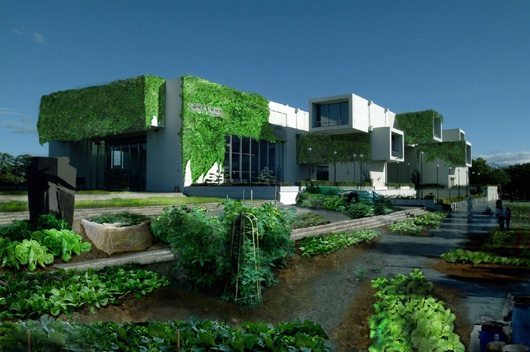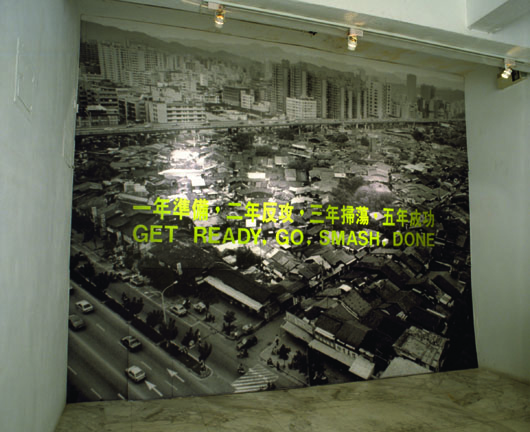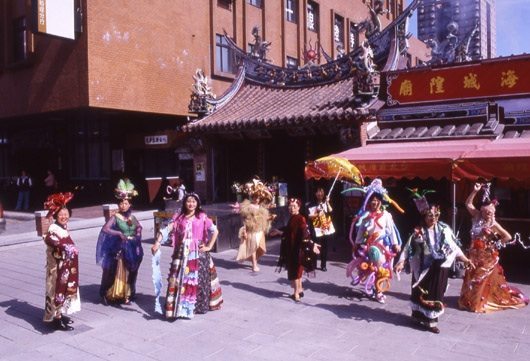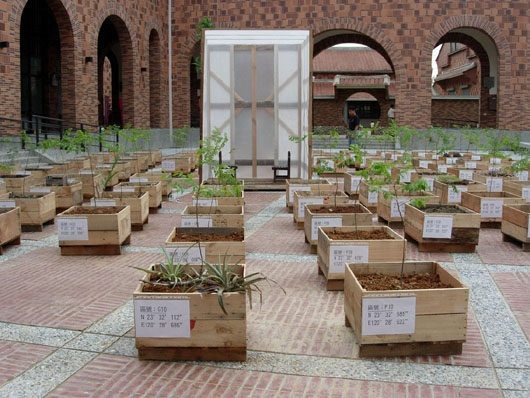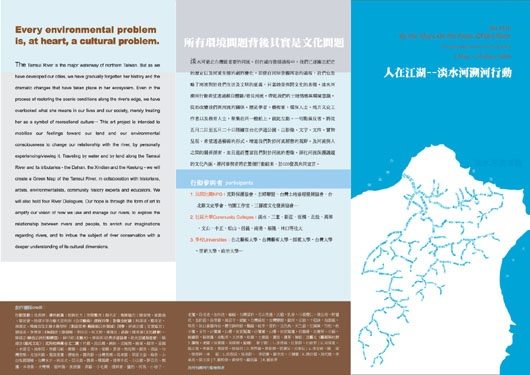Title: Bringing Ecoart to Taiwan
Editor’s Note
WEAD honors Wu Mali as Featured Artist for Issue #4. For twenty plus years, she has worked throughout Taiwan to disseminate awareness of community based feminist and environmental art. A quintessential multi-tasker, Mali wears multiple art coats: a progressive conceptual artist, educator, translator, environmentalist, feminist, activist, and educator. Just ten years ago few Taiwanese knew more about art than what was shown in galleries and museums. Today, thanks to Mali’s groundworks, a new generation of Taiwanese artists has emerged to create urban and rural projects–working with communities, scientists, and institutions, to clean wetlands, save soil and species, often using indigenous materials and traditions.
INTRODUCTION
IN THE PAST 10 YEARS, MY ARTWORKS HAVE focused on issues of community and environment, and my working method has evolved from engaging the public to combining my artistic practice with research and teaching in the university.
I. INTRODUCING SOCIAL CRITICAL ARTWORKS TO TAIWAN
DURING THE 80’S AND 90’S, INSPIRED by the avant-garde art movement, I translated books about Dadaism, the biography of Joseph Beuys, and developments of ‘action art” to introduce social and critical artworks to the Chinese-speaking world.
Back then, the art community in Taiwan still held to the idea of ‘art for art sake.’ But after the ban on Martial Law in Taiwan in 1987, we were confronted with intense political changes that I reconsidered how art might reconnect to the actual living world and people.
II. NEW CRITICAL WORKS, 1990’s
MY WORKS IN THE 90’S RESPONDED TO SOCIAL issues. I reinvestigated the relations of women throughout history, urban development, and economics from a feminist point of view. This series of works, including Stories of Women from Hsing-Chuang (1997), Epitaph (1997), Formosa Club (1998), Birds Slide over the Sky (1998), etc. were exhibited at Treasure Island, San Francisco, CA in 1998. By representing individual stories, I revealed biases in the ‘official narration’ of history.
I began wondering how critical works could be more than just displays in a museum or gallery space, how to actually connect works with audience, and furthermore, how to initiate change and give the voiceless a voice. I became inspired by historical avant-garde strategies such as art interventions critiquing social practices and ethics.
III. OUTSIDE THE GALLERY: TAIWANESE FEMINIST ART
AS A CONSEQUENCE OF MY CONTACT WITH the Taiwanese feminism movement, I collaborated with Taipei Women’s Awakening Association (TWAA) from 2000 to 2004 on the Fun Textile Workshop, producing a community-based art project, Awake in Your Skin.
TWAA organized the Fun Textile Workshop for housewives from traditional communities, and aimed to inspire these conservative women to become aware of public issues through textile arts workshops. The gatherings, however, failed to fulfill such objectives. Later, when I myself started to participate in the workshop, I used the concept of ‘subversive stitching’ to help these women review their actual life experiences via their familiar sewing technique. By sharing stories, they began to think out-of-the-box and understand that everything personal is political. The women began to see new possibilities in themselves.
There are three works in the series Awake in Your Skin: Bed Sheets of Soul, Theater Under the Skirts, and Empress’ New Dresses. We explored women’s personal life experiences, desires, and identities through intimate material, such as fabrics. This particular experience allowed me to witness the force of art. Unlike an abstract or formal discussion common in art circles, working on these pieces initiated changes through the subtle approach of art: calling forth the experiences of real lives through simple lines, materials, and techniques. Experienced activists in the feminist movement were impressed by our final presentation, for their life-long pursuits were already rooted in the local communities.
However, art education and our feminism movement— were still appealing only to subjects from the elite class, and could not be understood by everyone. TWAA later produced the film Stitching Sisterhood for their campaign to help initiate changes in middle and lower classes through creative media. We also spread understanding through discussions and writing. By attending sharing sessions I saw how art can transform public life.
IV. INTRODUCING NEW GENRE PUBLIC ART TO TAIWAN
I WAS STILL UNCLEAR ABOUT WHAT KIND of art intervention would be appropriate. I started to translate the book Mapping the Terrain: New Genre Public Art (ed. Suzanne Lacy) with some friends, and later another book Conversation Pieces: Community and Communication in Modern Art by Grant Kester.
During this time, I participated in the project Taipei City On The Move curated by Jo Hsiao and the Public Art Seminar organized by the Dimension Endowment of Art, and introduced Suzanne Lacy and Mary Jane Jacob (who curated Culture in Action in Chicago) to the organizers.
Lacy and Jacob were invited to promote community-based art practices and curatorial works in Taiwan. This phenomenally inspired local art practices and academic discussions on aesthetics. I began thinking more about relations between art and democracy, and community interventions.
V. ENGAGING RURAL COMMUNITIES
IN 2005, I WAS INVITED TO CURATE AN ART FESTIVAL in mostly agricultural Chiayi County, where there was a lack of cultural resources. I proposed a participatory project to engage different communities and social clubs to reflect on the conditions of withering rural villages caused by globalization and urbanization. Young people were leaving the countryside for cities, and the original structure of rural villages was collapsing. Meanwhile, over-populated cities had become cogs in the machinery of the capitalist world factory and were vulnerable to a diminishing humanity.
I wanted to reconsider the values of life in rural areas and find opportunities to reconstruct human relations again there. In this project, I invited local and foreign artists to plant trees along the Tropic of Cancer.
VI. ART AS ENVIRONMENT — RURAL ART RESIDENCY
FROM 2006 TO 2007, I CURATED ANOTHER project Art as Environment: A Cultural Action on the Tropic of Cancer, Chiayi County. Instead of asking artists to exhibit their works, we offered them residencies in rural villages to converse with residents and develop possible collaborations. In two years, more than 30 artists participated in 20 different communities. With the assistance of the Chiayi Culture Bureau, this project’s sites included mountains, plains and beaches around Chiayi County, and had an enormous impact on the region.
The rural populations consisted mostly of elderly people and children. Artists organized photography and drawing classes to teach children how to document their own surroundings, and collaborated with daycare centers to teach pottery-making, dancing and drumming.
We also encouraged local residents to re-envision their own traditional culture in new ways, e.g. making their own traditional handcrafted object for rituals, stories, and town histories. Due to the participation of local people, community life was reshaped. This successful project earned a great deal of approval. People began to realize that art could facilitate a different mobility in community building and create values with diverse approaches.
This project challenged artists to really look at Taiwanese social issues. The art action was later used as an example to demonstrate the central government’s policy-making in relation to artist residency programs, art interventions, and community building.
VII. WATER PROJECTS
BEFORE THE PROJECT OF ENVIRONMENTAL ART action in Chiayi, I created, By the River, on the River, of the River (2006), in collaboration with several community colleges in both Taipei City and Taipei County. It addressed the conditions of the four main rivers, which converge into the Pacific around my home in Tamsui, Taipei. For research, we took many river- trekking trips guided by local environmentalists.
I also made Taipei Tomorrow as a Lake again with the Organization of Urban Re-s (OURs) for the 2008 Taipei Biennial to investigate the potential influence of climate change on Taipei. Through a series of workshops, we created an art platform for urban planners and environmentalists to discuss and offer proposals for the future of Taiwan.
Community work requires long-term commitment to help people manage their own communal affairs. These are usually highly complex and intertwined with peculiar social, economic and ecological context.
In 2010, I started a project in my own neighborhood collaborating with Margaret Shiu, director of the Bamboo Curtain Studio, Jui-Mao Huang, professor in the Architecture Department, Tamkang University, local students from elementary and junior high schools, and friends. I was interested in creating a sustainable long term project. We proposed ideas to deal with pollution of Plum Tree Creek, and offered artistic proposals to improve the living quality in our own neighborhood.
VIII. CONCLUSION
UNDER THE GREAT CHALLENGE OF CLIMATE change, we hope the fairness we seek can be realized in our environment. I still believe in what I stated in the project, Art as Environment: A Cultural Action on the Tropic of Cancer, that ‘art is not for beautification, but a means of evoking, connecting and provoking.’

